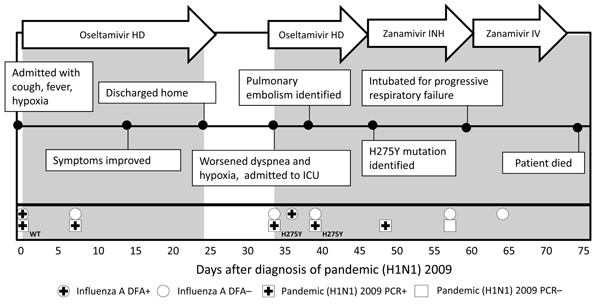Volume 16, Number 12—December 2010
CME ACTIVITY - Research
Pandemic (H1N1) 2009 Infection in Patients with Hematologic Malignancy
Figure 2

Figure 2. Clinical course for a 45-year-old woman (Table 3) hospitalized (periods indicated by gray shading) with influenza-associated pneumonia and concurrent pulmonary aspergillosis. The patient had received an autologous stem cell transplant 1 year earlier and underwent treatment with high-dose (HD) steroids for carmustine (BCNU) pneumonitis. On admission, she received HD oseltamivir (150 mg orally 2×/d) for 14 days, and antifungal therapy was initiated. Test results were positive for wild-type (WT) pandemic (H1N1) 2009 by PCR and influenza A by direct fluorescent antibody (DFA). A repeat pandemic (H1N1) 2009 PCR result was positive 1 week into treatment, but her condition later improved, and she was discharged to home. Ten days later, she was readmitted to the intensive care unit (ICU) with worsening dyspnea and again had positive test results for pandemic (H1N1) 2009; a pulmonary embolus was found. HD oseltamivir was restarted, but when pandemic (H1N1) 2009 PCR results remained persistently positive, she was switched to inhaled (INH) zanamivir and then intravenous (IV) zanamivir after intubation. PCR results indicated the H275Y mutation, confirming oseltamivir resistance. She eventually showed evidence of viral clearance but died of respiratory failure secondary to adult respiratory distress syndrome, pulmonary embolus, progressive pulmonary aspergillosis, and BCNU pneumonitis. PCR results were returned 5–11 days after specimen submission.